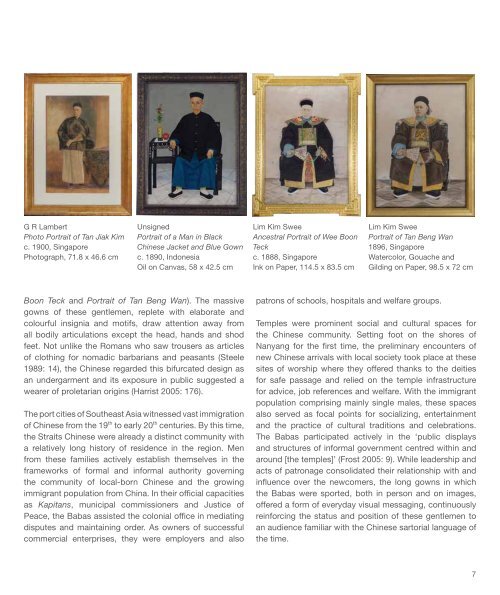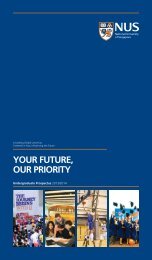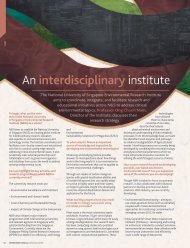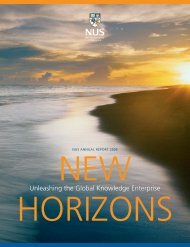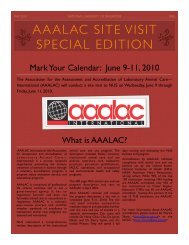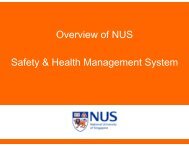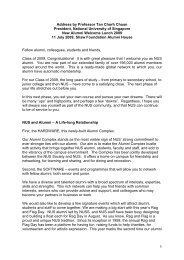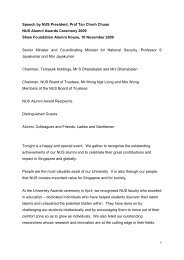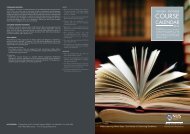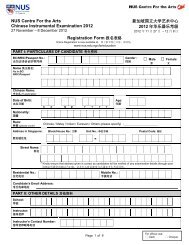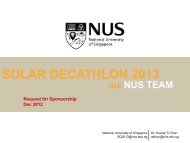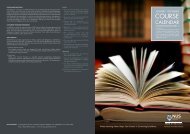Exhibition brochure - NUS - Home
Exhibition brochure - NUS - Home
Exhibition brochure - NUS - Home
Create successful ePaper yourself
Turn your PDF publications into a flip-book with our unique Google optimized e-Paper software.
G R Lambert<br />
Photo Portrait of Tan Jiak Kim<br />
c. 1900, Singapore<br />
Photograph, 71.8 x 46.6 cm<br />
Unsigned<br />
Portrait of a Man in Black<br />
Chinese Jacket and Blue Gown<br />
c. 1890, Indonesia<br />
Oil on Canvas, 58 x 42.5 cm<br />
Lim Kim Swee<br />
Ancestral Portrait of Wee Boon<br />
Teck<br />
c. 1888, Singapore<br />
Ink on Paper, 114.5 x 83.5 cm<br />
Lim Kim Swee<br />
Portrait of Tan Beng Wan<br />
1896, Singapore<br />
Watercolor, Gouache and<br />
Gilding on Paper, 98.5 x 72 cm<br />
Boon Teck and Portrait of Tan Beng Wan). The massive<br />
gowns of these gentlemen, replete with elaborate and<br />
colourful insignia and motifs, draw attention away from<br />
all bodily articulations except the head, hands and shod<br />
feet. Not unlike the Romans who saw trousers as articles<br />
of clothing for nomadic barbarians and peasants (Steele<br />
1989: 14), the Chinese regarded this bifurcated design as<br />
an undergarment and its exposure in public suggested a<br />
wearer of proletarian origins (Harrist 2005: 176).<br />
The port cities of Southeast Asia witnessed vast immigration<br />
of Chinese from the 19 th to early 20 th centuries. By this time,<br />
the Straits Chinese were already a distinct community with<br />
a relatively long history of residence in the region. Men<br />
from these families actively establish themselves in the<br />
frameworks of formal and informal authority governing<br />
the community of local-born Chinese and the growing<br />
immigrant population from China. In their official capacities<br />
as Kapitans, municipal commissioners and Justice of<br />
Peace, the Babas assisted the colonial office in mediating<br />
disputes and maintaining order. As owners of successful<br />
commercial enterprises, they were employers and also<br />
patrons of schools, hospitals and welfare groups.<br />
Temples were prominent social and cultural spaces for<br />
the Chinese community. Setting foot on the shores of<br />
Nanyang for the first time, the preliminary encounters of<br />
new Chinese arrivals with local society took place at these<br />
sites of worship where they offered thanks to the deities<br />
for safe passage and relied on the temple infrastructure<br />
for advice, job references and welfare. With the immigrant<br />
population comprising mainly single males, these spaces<br />
also served as focal points for socializing, entertainment<br />
and the practice of cultural traditions and celebrations.<br />
The Babas participated actively in the ‘public displays<br />
and structures of informal government centred within and<br />
around [the temples]’ (Frost 2005: 9). While leadership and<br />
acts of patronage consolidated their relationship with and<br />
influence over the newcomers, the long gowns in which<br />
the Babas were sported, both in person and on images,<br />
offered a form of everyday visual messaging, continuously<br />
reinforcing the status and position of these gentlemen to<br />
an audience familiar with the Chinese sartorial language of<br />
the time.<br />
7


